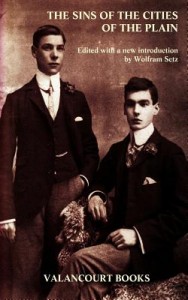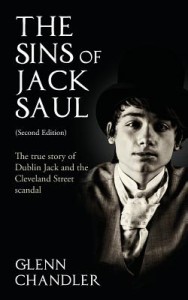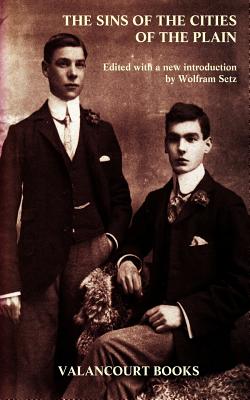 The Sins of the Cities of the Plain
The Sins of the Cities of the Plain
Edited by Wolfram Setz
Valancourt Books. 89 pages, $14.99
 The Sins of Jack Saul: The True Story of Dublin Jack and the Cleveland Street Scandal (Second Edition) by Glenn Chandler
The Sins of Jack Saul: The True Story of Dublin Jack and the Cleveland Street Scandal (Second Edition) by Glenn Chandler
Grosvenor House. 312 pages, $15.99
AS EARLY AS 1964, Montgomery Hyde, in his book A History of Pornography, brought to our attention the first pornographic work in English to feature a male homosexual: The Sins of the Cities of the Plain, or The Recollections of a Mary-Ann, published anonymously in 1881. Oscar Wilde bought a copy at the end of the decade. But for 20th-century readers, the work remained unavailable.
In 1992, Masquerade Books included the title as part of their Badboy series. It was not until Valancourt brought out its edition in 2012 that the majority of us learned of the deception Badboy had sprung on readers. The original contains several heterosexual scenes; Badboy made them all homosexual. Though the original is sexually explicit, it was not enough for the Badboy editor; he added gobs of newly created material. A number of scholars admonished readers that the text was corrupt, but one would have had to stumble upon their warnings to know. The authentic Valancourt text arguably has no greater literary value than the Badboy travesty, but now, at least, the work’s cultural significance is secure.
Sins of the Cities presents the first history of a male prostitute as told from his own viewpoint—and without apology. Its main character is Jack Saul, whose life is written up from “his rough notes” commissioned by a certain “Mr Cambon.” The two men first meet in November 1880, when Cambon cruises Saul in Leicester Square, being attracted by the “extraordinary” size of the “lump in his trousers.” He is equally struck by Saul’s expertise at oral sex and asks for an account of how he arrived at such proficiency. Saul agrees to provide a narration of his life, with the understanding that he will be paid for his efforts. Saul is thus frequently cited as the “author” of the resulting book. If so, he must share the title with Cambon. The latter’s introduction takes up seven-and-a-half pages in the Valancourt edition. His voice returns for eight pages at the end of the book in three essays apparently designed as filler to reach the requisite length.
The remaining 68 pages of text are in Saul’s voice. In sometimes comical terms, he recounts his upbringing on a Suffolk farm (one of the more memorable episodes is a woman servant’s unorthodox use of a cow’s teat as a substitute for a penis), his introduction to homosexuality during his brief experience in a boys’ boarding school, and his tenure in the “linendrapery house” of “Cygnet and Ego” (i.e., the real firm of Swan and Edgar), a job he loses as the result of providing more than clerical services to one of his female customers. (While drawn primarily to men, Saul is not exclusively homosexual.) At this point he begins his life as a rent boy. Halfway through the narrative, he asks, “You remember the Boulton and Park case?” The eighteen pages devoted to his encounter with the notorious cross-dressing pair has drawn the most attention to the book.
Neil McKenna, author of The Secret Life of Oscar Wilde, published his account of the pair in 2013 as Fanny and Stella: The Young Men Who Shocked Victorian England. Ernest Boulton, aka Stella, and Frederick William Park, aka Fanny, appeared on stage under their feminine names, disguising their gender. (Although they are generally treated as drag queens, it seems more probable they were transwomen in today’s nomenclature.) They were arrested outside a London theater in 1871 under suspicion of having committed sodomy. At the time Bolton was living with Lord Arthur Clinton, a
former member of Parliament, who died, almost certainly of suicide, before he could be questioned. John Fiske, the U.S. consul at Edinburgh, was also compromised. The artist Simeon Solomon attended the trial and reported on the proceedings to the poet Algernon Swinburne. In Sins of the Cities of the Plain, Saul remembers only his earlier, happier times and the sexual hijinks they engaged in, during which he also dressed as a woman. Along the way, Saul also mentions having met the very heterosexual Prince of Wales.
Intriguingly, Jack Saul happens to be the name of a very real rent boy who was involved in two homosexual scandals a few years after the book was published. His name cropped up as part of the so-called Dublin Castle scandal of 1884, in which a number of brothel keepers, Irish officials, and British soldiers were tried for sodomy. He resurfaced as part of the 19 Cleveland Street scandal of 1889, in which an investigation into a male brothel using postal messenger boys as prostitutes was sidetracked when it became obvious that members of the upper crust (including perhaps Prince Edward) would have their reputations besmirched. So the question emerges: is Sins of the Cities a memoir or a novel? In 2014, I chose it as the starting point for my Gay Novels of Britain, Ireland and the Commonwealth, 1881–1981. There I lamented: “No one seems to have attempted even a mini-biography of Saul.” Even as I typed those words, Glenn Chandler was working to remedy that deficiency.
The writer of the 2011 musical Cleveland Street, Chandler had chosen Saul to narrate his lyrical treatment of the scandal. As part of his research he had seen the deposition signed by Saul. Then, by pure serendipity, Chandler encountered the same signature on a 1901 Irish census. With these leads, he was now able to track down all sorts of information about John Saul on both sides of the Irish Sea. It is an extraordinary story that Chandler has assembled. He published it first in March 2016. His musical version of the biography opened in London in May. As a result of information fans of the book and the musical brought to his attention, an expanded edition of the biography appeared in August 2016. The latter is the one to read.
John Saul was born on October 29, 1857, in Dublin, into an impoverished Catholic family. His good looks, winning ways, and perhaps that “priapus nearly ten inches long” (as Cambon describes it) gained the attention of a number of well-placed Dubliners who were later to figure prominently in the Dublin Castle scandal. After a run-in with a legitimate employer (Saul was accused of robbery), he emigrated to London in 1879. There the 21-year-old quickly renewed his calling as a rent boy, gaining the nickname “Dublin Jack.” A year later he ran into “Mr Cambon.” Saul had already teamed up with Charles Hammond, later the proprietor of 19 Cleveland Street. Although they parted ways before the scandal broke, Saul’s knowledge became important to the subsequent trials. Chandler reproduces Saul’s written affidavit in full. The document proves that he was quite literate, making the case all the stronger that much of his memoir may be in his own hand. The affidavit’s concluding statement also has linguistic interest. There he records: “I occasionally do odd jobs for different gay people” (italics mine).
His career as a rent boy ended because of both his age and his testimony in a libel case that grew out of the Cleveland Street investigation. After that, Saul acted briefly in a Drury Lane play. Next he obtained another job as a servant, but he soon decided that it was time for him to return to Ireland. There he came down with tuberculosis. After living for a while with his brother, he was moved to the hospice at Harold’s Cross. There he died on August 28, 1904, just two months shy of his forty-seventh birthday. Chandler goes over ground covered in other histories about the two (or three) scandals, but by linking them to the person of Jack Saul, he provides a more integrated view of the network of gay relationships connecting them all. Chandler also follows the lives of the other players in Saul’s life until their deaths or disappearances. The great unsolved mystery remains the identity of Cambon. Chandler presents several possibilities but leans strongly in the direction of none other than the painter Simeon Solomon.
Chandler also makes it clear how much of The Sins of the Cities of the Plain has to be fiction. Clearly, the episodes in Suffolk were invented. The Boulton–Park case occurred in 1870, when Saul was a twelve-year-old boy living in Dublin. The meeting with the Prince of Wales would likewise have to be fictitious. Chandler leaves open whether Saul’s brief employment at Swan and Edgar was factual or invented. Scholars may despair that Chandler created dialog and didn’t annotate his sources save in a general way. I am not an expert on the Victorian period, but in those cases where I’ve been able to match his sources with his biography, I find that he is accurate. Together, the Valancourt edition and the biography should move what has hitherto been a footnote in gay cultural history up into the main text. Chandler records how, during the run of his second musical, “an audience member tweeted that Jack Saul was ‘the patron saint of rent boys the world over.’”
Drewey Wayne Gunn is professor emeritus at Texas A&M University–Kingsville.






